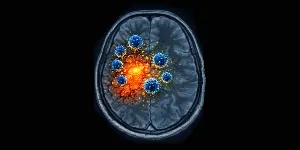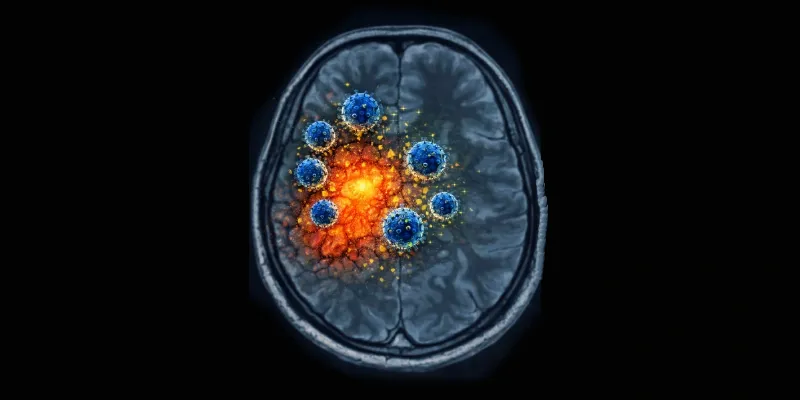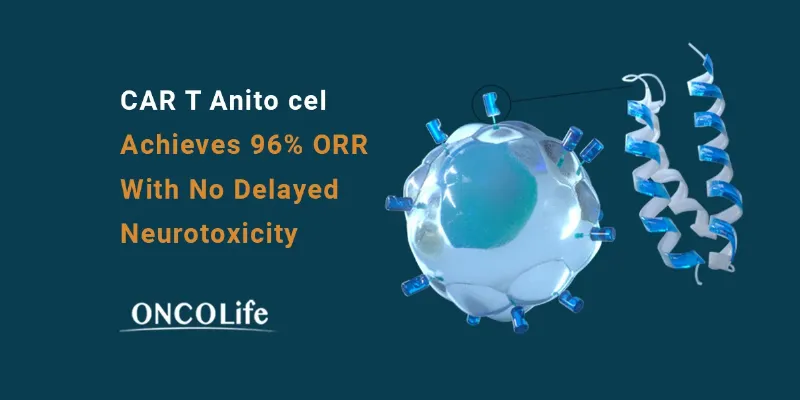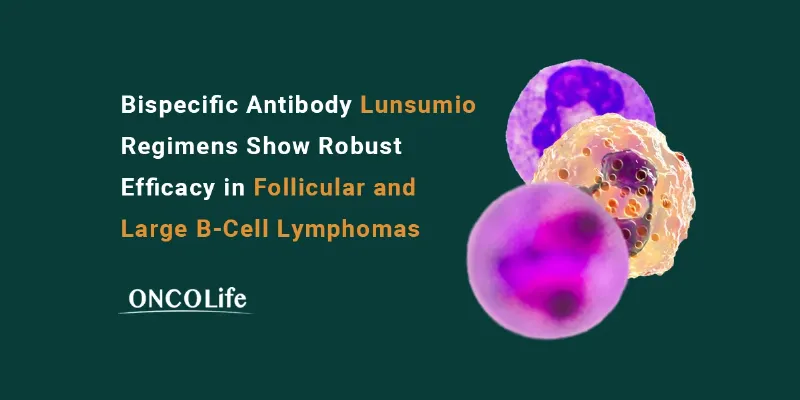Panna Sharma: AI to Transform Cancer Care and Usher in a New Era of Medicine


ONCOLife |
19 April 2024
In an exclusive ONCOLife interview, Lantern Pharma’s CEO Panna Sharma highlights the transformative role of Artificial Intelligence (AI) in oncology, streamlining early drug discovery and developing targeted therapies for complex cancers. Sharma stated that the power of AI in drug development and personalized medicine is leading to significant milestones in oncology.
The Golden Age of Medicine Powered by AI
Panna Sharma envisions a golden age of medicine driven by AI, aiming to dramatically lower costs and speed up the creation of new treatments. This revolution is poised to fundamentally transform cancer treatment and patient care.
Click the picture to view the PDF version: Pg 34-39.
Where are we in using AI and ML in drug research and finding new therapies for cancer? How will AI and ML change the future of cancer research?
Panna Sharma: We’re just at the beginning stages of integrating AI in oncology, with a modest number of AI-driven molecules and even fewer reaching phase 2 trials. Our focus is on harnessing AI for early discovery, aiming to make this process both faster and more cost-effective. The advent of AI in drug development raises pivotal questions about its role, whether in sparking new waves of discovery or achieving breakthrough treatments. The complexity of oncology, with its vast array of cancer types and the evolutionary nature of the disease, presents extraordinary challenges that AI is uniquely equipped to address.
AI is revolutionizing the way we approach drug development, enabling us to navigate the diverse and evolving landscape of cancer. It allows for the identification of the right indications for new treatments and optimizes drug combinations, addressing the intricacies of cancer’s prog ression and the specificity of its treatment. This capability is not about generating new treatments but about ensuring they are directed where they can be most effective.
A New Era in Cancer Care with AI
The integration of AI into medicine signals a golden age, promising to accelerate the development of new medicines with unprecedented precision and safety. It levels the playing field for smaller companies by making drug discovery and development more accessible, less expensive and with the ability to iterate on ideas in a matter of days or weeks and not months and years.
Additionally, AI is streamlining the process of tackling complex drug combination challenges, potentially saving both time and significant financial resources. AI’s impact on drug development is expected to be profound and rapid, reflecting the accelerated pace of technological innovation. This impact is particularly notable in oncology, neurodegenerative disorders, and metabolic conditions, where AI’s contributions to personalized medicine are becoming increasingly significant.
Moreover, AI’s role in addressing rare cancers and diseases showcases its potential to drive significant advances. Our work, for example, has led to the identification of treatments for ultra-rare cancers such as ATRT, facilitated by AI’s ability to enhance molecular characterization and targeting. This work underscores the power of AI in advancing our understanding and treatment of rare conditions.
Looking ahead, the use of AI in drug development is poised to dramatically reduce the costs associated with early-stage discovery, ushering in a new era of innovation. This promising future is marked by the development of novel molecules aimed at a broad spectrum of cancer subtypes and rare diseases, thus highlighting the transformative potential of AI in medical science.
Can you elaborate on how the evolution of the RADR platform, especially surpassing 60 billion data points, has impacted the development of new therapies?
Panna Sharma: Our drug, LP 284, progressed from a mere concept to an oncology clinical trial in under three years, an achievement that cost less than $3 million. This rapid development, from whiteboard idea to phase one trial, including achieving two orphan indications and presenting at prestigious conferences like SOHO, ASH, and AACR, was unprecedented.
The use of AI was pivotal, enabling us to identify and optimize the drug’s core molecular features efficiently and select indications where we had a high chance of success. Our analysis included an expansive genomic and proteomic understanding of various cancers, particularly hematologic B cell malignancies, guiding the drug’s targeted development.
With RADR expected to surpass 100 billion data points in 2024, how do you see this growth enhancing its ability to predict and improve outcomes for complex oncology cases and rare cancers?
Panna Sharma: As cancers evolve through various stages, becoming more complex, the need for combination therapies involving two or three drugs becomes crucial. This complexity, encompassing the evolution of both the cancer and the patient, presents a significant challenge well-suited for AI. Utilizing AI, we can model these combinations to understand their safety profiles better. With more comprehensive data-spanning safety, chemical features, environmental factors, and immune responses we enhance our ability to predict effective drug combinations, safety aspects, and potential drug-drug interactions, optimizing treatment strategies.
Could you provide some information about the Harmonic™ trial involving LP-300, its current status, and your expectations?
Panna Sharma: We’re currently advancing three drugs through trials, notably LP 300, which is under evaluation in a 90-patient harmonic trial across East Asia and the United States. Intriguingly, LP 300 has shown promising efficacy in never-smokers, a group distinguished by unique genomic and biomarker profiles from smokers. This differentiation lies in their distinct mutational landscapes and lack of PD-L1 expression, rendering immune response drugs less effective.

Given the absence of approved treatments for never-smokers—a sadly expanding demographic—LP 300 could prove to be a valuable therapeutic option, especially in combination with existing chemotherapy. This insight is purely data-driven. Meanwhile, our other drugs, LP 184 and LP 284, are progressing through phase one trials, with promising developments expected this year.
Lantern is develoing seve-ral drugs for difficult-to-treat cancers. Can you share insights into other promising drug candidates in your pipeline, particularly LP-184 and LP-284, and their target indications?
Panna Sharma: LP 184 and LP 284, both in phase one trials, are standout clinical candidates. LP 184 excels in treating solid tumors with deficiencies in DNA damage repair pathways, showing broad effectiveness across various solid tumors. LP 284, on the other hand, targets B-cell malignancies, effectively destroying B cells even when other treatments fail.
Additionally, we’re launching Starlight Therapeutics, focusing exclusively on brain cancer treatments, with our promising Star 001 drug targeting five different brain cancer indications. Moreover, we’re advancing preclinical programs in antibody-drug conjugates (ADCs), anticipating that ADC candidates will enter clinical trials soon. This is part of our commitment to the next wave of precision therapeutics.
How has the RADR® platform’s focus on drug sensitivity data and combination treatment outcome data led to tangible advancements in understanding which patient groups might benefit most from your therapies?
Panna Sharma: RADR focuses on enhancing drug development not just by creating effective drugs but by identifying the right patient profiles, which traditionally can take years. By developing biomarker signatures early or alongside drug development, we aim for faster, safer, and more cost-effective trials with fewer adverse events. Improving the biomolecular and genomic characterization of molecules enables better-guided trials and more precise patient selection, ultimately reducing costs and driving efficiency in the drug development process. Drug resistance remains a significant challenge in cancer treatment.
How does Lantern Pharma plan to use RADR® to identify early signs of resistance and develop strategies to overcome or mitigate these issues?
Panna Sharma: While we can perform extensive modeling, understanding drug resistance fully requires large-scale trials due to the variety of resistance factors, like active or passive mechanisms and clonal evolution. Currently, efforts like mutation profiling and clonal evolution studies are theoretical and necessitate more clinical data.
The discrepancy between models based on preclinical studies and actual human biology underscores the need for trial data to inform AI platforms for better modeling. This approach to tackling drug resistance is still in its infancy in our industry, highlighting the journey ahead in refining our strategies.
As AI continues to play a crucial role in drug development, how do you envision the future integration of AI technologies in clinical practice, particularly for oncologists?
Panna Sharma: Clinical adoption of data-driven trial designs and drug prescriptions is lagging, primarily due to concerns about safety, protocols, and guidelines. Many oncologists still prefer traditional treatments for all lung cancer patients, regardless of specific biomarkers like PDL1 levels or TMB status, indicating a resistance to adopting new methodologies.
However, I anticipate that emerging technologies will significantly enhance clinician productivity, especially for oncologists, by providing co-piloting tools for managing complex treatment sequences and interpreting advanced biomarker signatures.
The integration of AI and real-time data analysis could revolutionize clinical practices, allowing immediate access to scans, genomic data, and biomarker information, which currently takes days to process. This shift could dramatically shorten decision-making times, improve clinician efficiency, and foster the adoption of more personalized medicine approaches.
Lantern is not a tool-making company at the current time, but, we recognize the importance of equipping healthcare professionals with better tools for data analysis and decision-making. The emergence of these tools, alongside a new generation of molecularly and biomarker-oriented clinicians, promises to accelerate adoption of personalized medicine.

I believe the next decade will be pivotal, with drug developers introducing new medicines and clinicians increasingly advocating for the-ir use among patients. This period is set to usher in a hyper-productive era in healthcare, particularly in developed countries, marking significant advancements in personalized medicine.
Could you discuss any current or planned collaborations with academic institutions, biotech firms, or pharmaceutical companies to advance the research and development of your drug candidates?
Panna Sharma: Our collaborations with esteemed institutions like Johns Hopkins Medicine, Danish Cancer Research Center, Fox Chase, and the University of Texas, particularly in areas of brain, bladder, pancreatic, and pediatric cancers, play a crucial role in our development process. These partnerships, including a significant one with Johns Hopkins leading to the creation of Starlight Therapeutics, provide invaluable expertise and guidance.
Collaborating with experts helps us validate the clinical relevance of our data and ensures our development decisions are sound. These collaborations enrich our programs with unique insights, models, and datasets, essential for dri-ving our AI and enhancing every one of our projects.
What are Lantern Pharma’s long-term goals and priorities for the next 5-10 years, both in terms of expanding your drug portfolio and further enhancing the RADR® platform’s capabilities?
Panna Sharma: Our RADR platform is evolving to include more generative AI capabilities, focusing on drug combinations, ultra-rare cancers, and how therapies and drug combinations can overcome clonal evolution and resistance. Over the next five years, we aim to partner or sell our promising drug candidates, like LP 300, LP 184, and LP 284, to large pharmaceutical companies.
We’re particularly excited about Starlight, a spin-off focused on CNS and brain cancers, which we also see as a potential partnership or sale opportunity. Our strategy involves reinvesting proceeds from partnerships and licensing in phase two and three stages into developing next-generation drug assets. Starlight, in particular, embodies our AI-driven approach, emerging from extensive data analysis in brain cancer research.
About Panna Sharma and Lantern Pharma
Could you provide us with an overview of your background and some general information about Lantern Pharma?
Panna Sharma: I joined Lantern Pharma in late 2018 as CEO, and was brought in by the venture capitalists who had initially funded and nurtured the company. I successfully raised $100 million – both in public and private rounds – developed the management team, and took the company public in 2020.
My university education was in AI, neural network theory and philosophy of science, but I veered towards biotech and life sciences, drawn by the impactful combination of corporate strategy and scientific advancement. Before this, I led an oncology-focused biotech and molecular genomics company, where I raised significant funds and also took that company public on Nasdaq.
My journey also includes a tenure as a chief strategy officer at a web-services, and tech-consulting firm during the dot-com era, followed by over a decade of experience in investment banking for life science sectors like personalized medicine and diagnostics. My education in AI and my passion for biotechnology, especially cancer research, found a harmonious blend in my current role. I see my work as a perfect opportunity to marry my background in AI, investment banking insights, and domain knowledge in oncology to make meaningful advancements in cancer treatment.











Comments
No Comments Yet!